Debenhams: A Strategic Analysis of Innovation and Adaptation
VerifiedAdded on 2021/06/30
|18
|7279
|130
Report
AI Summary
This report provides a comprehensive analysis of Debenhams' strategic adaptation to the changing retail landscape, focusing on the impact of the digital economy. It begins with an executive summary, followed by an introduction covering the theoretical background of innovation and Debenhams' profile, including a SWOT analysis. The report then delves into Debenhams' internal factors, such as leadership, structure, and culture, examining the transition from previous leadership to Sergio Bucher's focus on online sales and customer experience. The analysis extends to external factors, including e-commerce trends and a Porter's Five Forces analysis, and evaluates Debenhams' new strategy. The report concludes with recommendations for Debenhams, addressing internal issues like communication channels and career progression, aiming to improve the company's innovation process and overall performance. The report draws upon the provided figures and tables to support its findings.
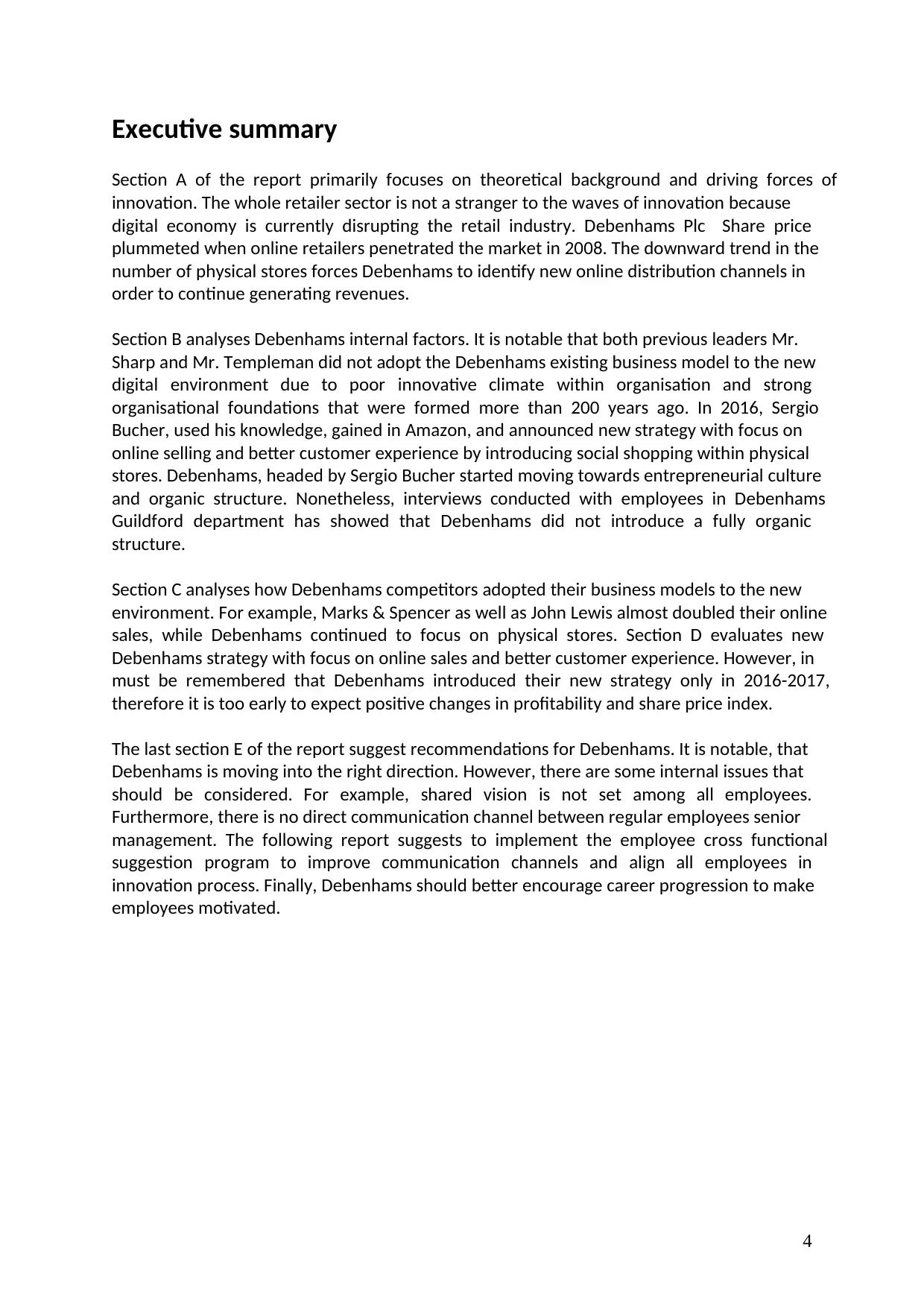
4
Executive summary
Section A of the report primarily focuses on theoretical background and driving forces of
innovation. The whole retailer sector is not a stranger to the waves of innovation because
digital economy is currently disrupting the retail industry. Debenhams Plc Share price
plummeted when online retailers penetrated the market in 2008. The downward trend in the
number of physical stores forces Debenhams to identify new online distribution channels in
order to continue generating revenues.
Section B analyses Debenhams internal factors. It is notable that both previous leaders Mr.
Sharp and Mr. Templeman did not adopt the Debenhams existing business model to the new
digital environment due to poor innovative climate within organisation and strong
organisational foundations that were formed more than 200 years ago. In 2016, Sergio
Bucher, used his knowledge, gained in Amazon, and announced new strategy with focus on
online selling and better customer experience by introducing social shopping within physical
stores. Debenhams, headed by Sergio Bucher started moving towards entrepreneurial culture
and organic structure. Nonetheless, interviews conducted with employees in Debenhams
Guildford department has showed that Debenhams did not introduce a fully organic
structure.
Section C analyses how Debenhams competitors adopted their business models to the new
environment. For example, Marks & Spencer as well as John Lewis almost doubled their online
sales, while Debenhams continued to focus on physical stores. Section D evaluates new
Debenhams strategy with focus on online sales and better customer experience. However, in
must be remembered that Debenhams introduced their new strategy only in 2016-2017,
therefore it is too early to expect positive changes in profitability and share price index.
The last section E of the report suggest recommendations for Debenhams. It is notable, that
Debenhams is moving into the right direction. However, there are some internal issues that
should be considered. For example, shared vision is not set among all employees.
Furthermore, there is no direct communication channel between regular employees senior
management. The following report suggests to implement the employee cross functional
suggestion program to improve communication channels and align all employees in
innovation process. Finally, Debenhams should better encourage career progression to make
employees motivated.
Executive summary
Section A of the report primarily focuses on theoretical background and driving forces of
innovation. The whole retailer sector is not a stranger to the waves of innovation because
digital economy is currently disrupting the retail industry. Debenhams Plc Share price
plummeted when online retailers penetrated the market in 2008. The downward trend in the
number of physical stores forces Debenhams to identify new online distribution channels in
order to continue generating revenues.
Section B analyses Debenhams internal factors. It is notable that both previous leaders Mr.
Sharp and Mr. Templeman did not adopt the Debenhams existing business model to the new
digital environment due to poor innovative climate within organisation and strong
organisational foundations that were formed more than 200 years ago. In 2016, Sergio
Bucher, used his knowledge, gained in Amazon, and announced new strategy with focus on
online selling and better customer experience by introducing social shopping within physical
stores. Debenhams, headed by Sergio Bucher started moving towards entrepreneurial culture
and organic structure. Nonetheless, interviews conducted with employees in Debenhams
Guildford department has showed that Debenhams did not introduce a fully organic
structure.
Section C analyses how Debenhams competitors adopted their business models to the new
environment. For example, Marks & Spencer as well as John Lewis almost doubled their online
sales, while Debenhams continued to focus on physical stores. Section D evaluates new
Debenhams strategy with focus on online sales and better customer experience. However, in
must be remembered that Debenhams introduced their new strategy only in 2016-2017,
therefore it is too early to expect positive changes in profitability and share price index.
The last section E of the report suggest recommendations for Debenhams. It is notable, that
Debenhams is moving into the right direction. However, there are some internal issues that
should be considered. For example, shared vision is not set among all employees.
Furthermore, there is no direct communication channel between regular employees senior
management. The following report suggests to implement the employee cross functional
suggestion program to improve communication channels and align all employees in
innovation process. Finally, Debenhams should better encourage career progression to make
employees motivated.
Paraphrase This Document
Need a fresh take? Get an instant paraphrase of this document with our AI Paraphraser
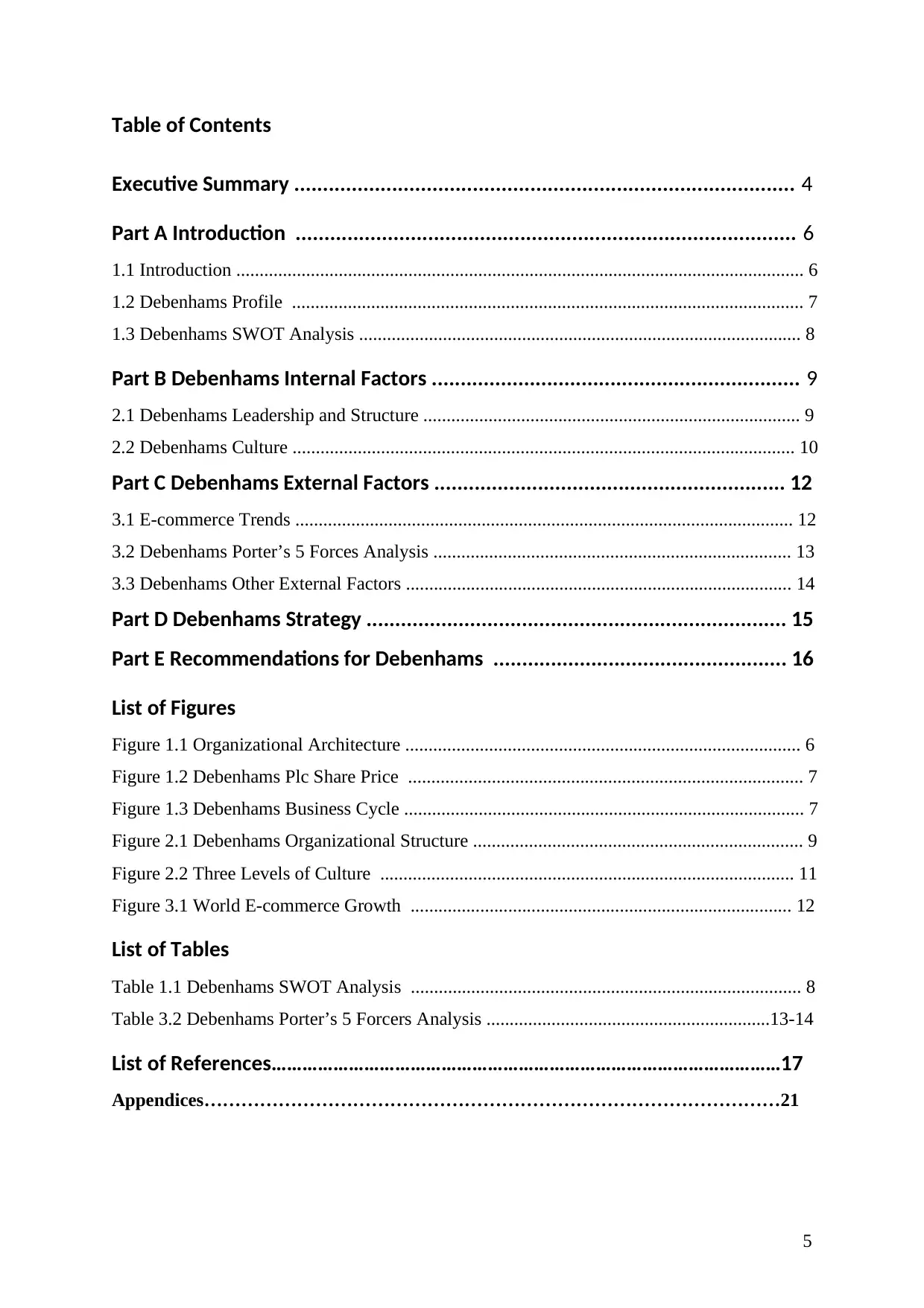
5
Table of Contents
Executive Summary ....................................................................................... 4
Part A Introduction ....................................................................................... 6
1.1 Introduction .......................................................................................................................... 6
1.2 Debenhams Profile .............................................................................................................. 7
1.3 Debenhams SWOT Analysis ............................................................................................... 8
Part B Debenhams Internal Factors ................................................................ 9
2.1 Debenhams Leadership and Structure ................................................................................. 9
2.2 Debenhams Culture ............................................................................................................ 10
Part C Debenhams External Factors ............................................................. 12
3.1 E-commerce Trends ........................................................................................................... 12
3.2 Debenhams Porter’s 5 Forces Analysis ............................................................................. 13
3.3 Debenhams Other External Factors ................................................................................... 14
Part D Debenhams Strategy ......................................................................... 15
Part E Recommendations for Debenhams ................................................... 16
List of Figures
Figure 1.1 Organizational Architecture ..................................................................................... 6
Figure 1.2 Debenhams Plc Share Price ..................................................................................... 7
Figure 1.3 Debenhams Business Cycle ...................................................................................... 7
Figure 2.1 Debenhams Organizational Structure ....................................................................... 9
Figure 2.2 Three Levels of Culture ......................................................................................... 11
Figure 3.1 World E-commerce Growth .................................................................................. 12
List of Tables
Table 1.1 Debenhams SWOT Analysis .................................................................................... 8
Table 3.2 Debenhams Porter’s 5 Forcers Analysis .............................................................13-14
List of References………………………………………………………………………………………17
Appendices…………………………………………………………………………………21
Table of Contents
Executive Summary ....................................................................................... 4
Part A Introduction ....................................................................................... 6
1.1 Introduction .......................................................................................................................... 6
1.2 Debenhams Profile .............................................................................................................. 7
1.3 Debenhams SWOT Analysis ............................................................................................... 8
Part B Debenhams Internal Factors ................................................................ 9
2.1 Debenhams Leadership and Structure ................................................................................. 9
2.2 Debenhams Culture ............................................................................................................ 10
Part C Debenhams External Factors ............................................................. 12
3.1 E-commerce Trends ........................................................................................................... 12
3.2 Debenhams Porter’s 5 Forces Analysis ............................................................................. 13
3.3 Debenhams Other External Factors ................................................................................... 14
Part D Debenhams Strategy ......................................................................... 15
Part E Recommendations for Debenhams ................................................... 16
List of Figures
Figure 1.1 Organizational Architecture ..................................................................................... 6
Figure 1.2 Debenhams Plc Share Price ..................................................................................... 7
Figure 1.3 Debenhams Business Cycle ...................................................................................... 7
Figure 2.1 Debenhams Organizational Structure ....................................................................... 9
Figure 2.2 Three Levels of Culture ......................................................................................... 11
Figure 3.1 World E-commerce Growth .................................................................................. 12
List of Tables
Table 1.1 Debenhams SWOT Analysis .................................................................................... 8
Table 3.2 Debenhams Porter’s 5 Forcers Analysis .............................................................13-14
List of References………………………………………………………………………………………17
Appendices…………………………………………………………………………………21
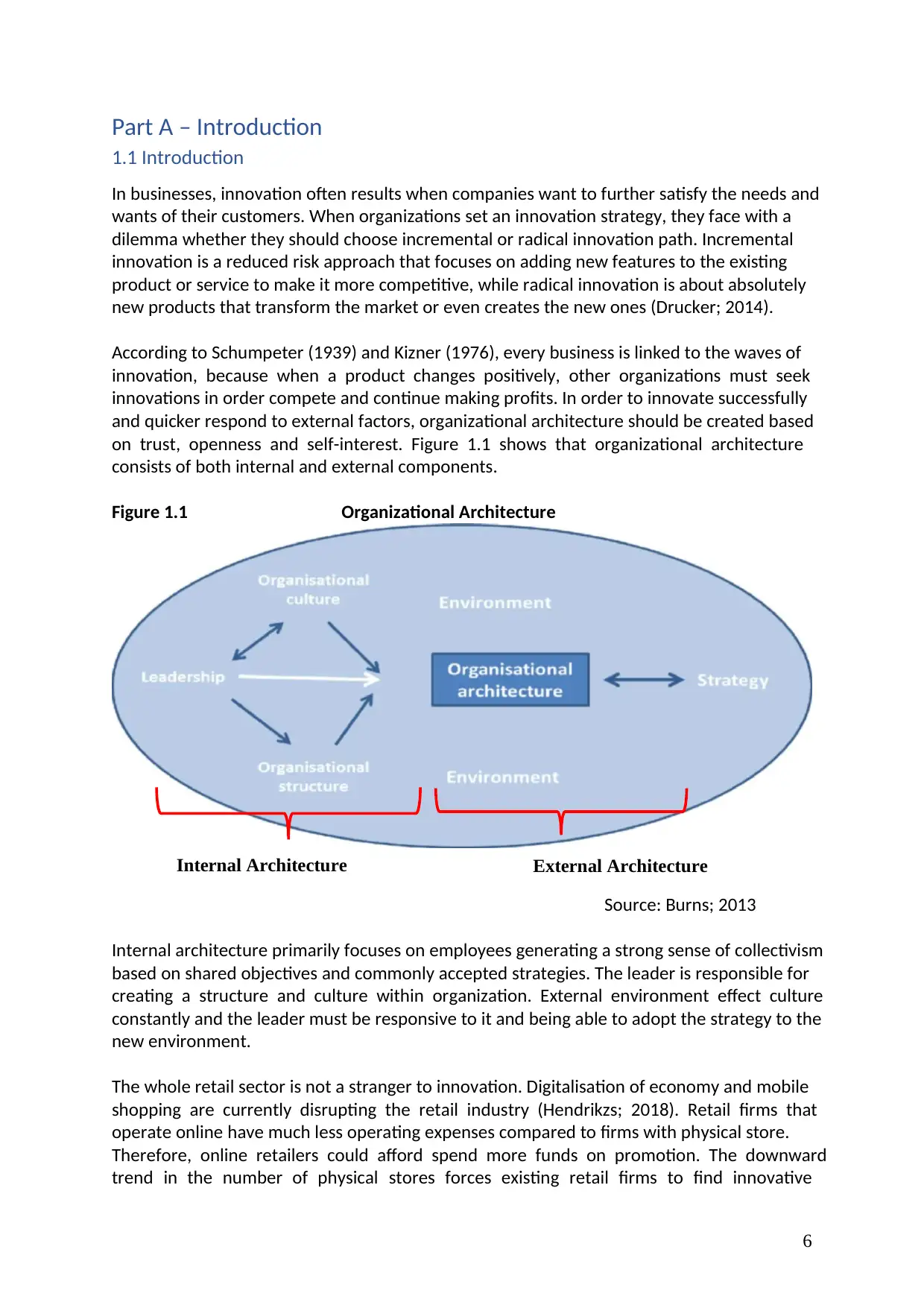
6
Part A – Introduction
1.1 Introduction
In businesses, innovation often results when companies want to further satisfy the needs and
wants of their customers. When organizations set an innovation strategy, they face with a
dilemma whether they should choose incremental or radical innovation path. Incremental
innovation is a reduced risk approach that focuses on adding new features to the existing
product or service to make it more competitive, while radical innovation is about absolutely
new products that transform the market or even creates the new ones (Drucker; 2014).
According to Schumpeter (1939) and Kizner (1976), every business is linked to the waves of
innovation, because when a product changes positively, other organizations must seek
innovations in order compete and continue making profits. In order to innovate successfully
and quicker respond to external factors, organizational architecture should be created based
on trust, openness and self-interest. Figure 1.1 shows that organizational architecture
consists of both internal and external components.
Figure 1.1 Organizational Architecture
Source: Burns; 2013
Internal architecture primarily focuses on employees generating a strong sense of collectivism
based on shared objectives and commonly accepted strategies. The leader is responsible for
creating a structure and culture within organization. External environment effect culture
constantly and the leader must be responsive to it and being able to adopt the strategy to the
new environment.
The whole retail sector is not a stranger to innovation. Digitalisation of economy and mobile
shopping are currently disrupting the retail industry (Hendrikzs; 2018). Retail firms that
operate online have much less operating expenses compared to firms with physical store.
Therefore, online retailers could afford spend more funds on promotion. The downward
trend in the number of physical stores forces existing retail firms to find innovative
Internal Architecture External Architecture
Part A – Introduction
1.1 Introduction
In businesses, innovation often results when companies want to further satisfy the needs and
wants of their customers. When organizations set an innovation strategy, they face with a
dilemma whether they should choose incremental or radical innovation path. Incremental
innovation is a reduced risk approach that focuses on adding new features to the existing
product or service to make it more competitive, while radical innovation is about absolutely
new products that transform the market or even creates the new ones (Drucker; 2014).
According to Schumpeter (1939) and Kizner (1976), every business is linked to the waves of
innovation, because when a product changes positively, other organizations must seek
innovations in order compete and continue making profits. In order to innovate successfully
and quicker respond to external factors, organizational architecture should be created based
on trust, openness and self-interest. Figure 1.1 shows that organizational architecture
consists of both internal and external components.
Figure 1.1 Organizational Architecture
Source: Burns; 2013
Internal architecture primarily focuses on employees generating a strong sense of collectivism
based on shared objectives and commonly accepted strategies. The leader is responsible for
creating a structure and culture within organization. External environment effect culture
constantly and the leader must be responsive to it and being able to adopt the strategy to the
new environment.
The whole retail sector is not a stranger to innovation. Digitalisation of economy and mobile
shopping are currently disrupting the retail industry (Hendrikzs; 2018). Retail firms that
operate online have much less operating expenses compared to firms with physical store.
Therefore, online retailers could afford spend more funds on promotion. The downward
trend in the number of physical stores forces existing retail firms to find innovative
Internal Architecture External Architecture
⊘ This is a preview!⊘
Do you want full access?
Subscribe today to unlock all pages.

Trusted by 1+ million students worldwide
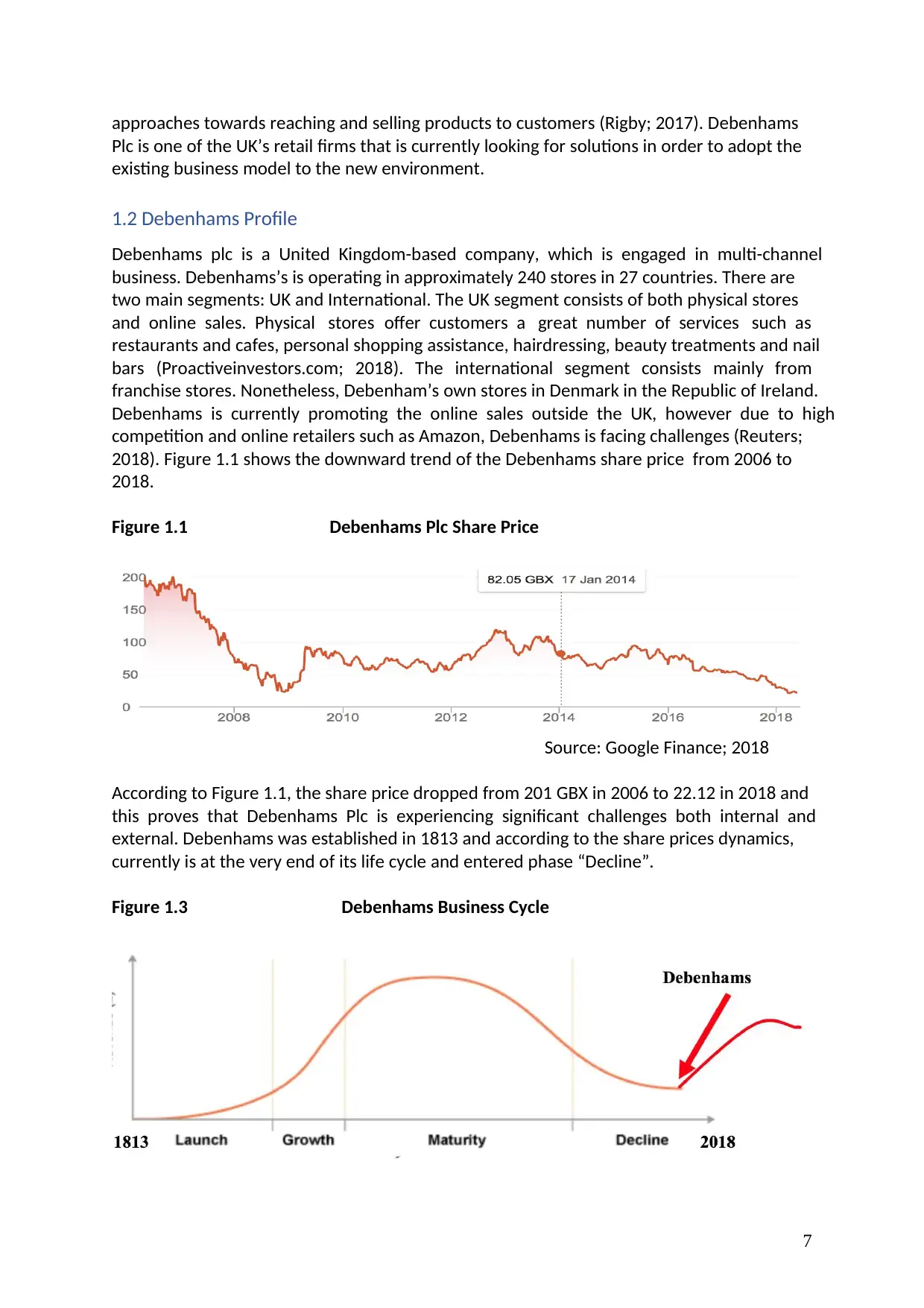
7
approaches towards reaching and selling products to customers (Rigby; 2017). Debenhams
Plc is one of the UK’s retail firms that is currently looking for solutions in order to adopt the
existing business model to the new environment.
1.2 Debenhams Profile
Debenhams plc is a United Kingdom-based company, which is engaged in multi-channel
business. Debenhams’s is operating in approximately 240 stores in 27 countries. There are
two main segments: UK and International. The UK segment consists of both physical stores
and online sales. Physical stores offer customers a great number of services such as
restaurants and cafes, personal shopping assistance, hairdressing, beauty treatments and nail
bars (Proactiveinvestors.com; 2018). The international segment consists mainly from
franchise stores. Nonetheless, Debenham’s own stores in Denmark in the Republic of Ireland.
Debenhams is currently promoting the online sales outside the UK, however due to high
competition and online retailers such as Amazon, Debenhams is facing challenges (Reuters;
2018). Figure 1.1 shows the downward trend of the Debenhams share price from 2006 to
2018.
Figure 1.1 Debenhams Plc Share Price
Source: Google Finance; 2018
According to Figure 1.1, the share price dropped from 201 GBX in 2006 to 22.12 in 2018 and
this proves that Debenhams Plc is experiencing significant challenges both internal and
external. Debenhams was established in 1813 and according to the share prices dynamics,
currently is at the very end of its life cycle and entered phase “Decline”.
Figure 1.3 Debenhams Business Cycle
approaches towards reaching and selling products to customers (Rigby; 2017). Debenhams
Plc is one of the UK’s retail firms that is currently looking for solutions in order to adopt the
existing business model to the new environment.
1.2 Debenhams Profile
Debenhams plc is a United Kingdom-based company, which is engaged in multi-channel
business. Debenhams’s is operating in approximately 240 stores in 27 countries. There are
two main segments: UK and International. The UK segment consists of both physical stores
and online sales. Physical stores offer customers a great number of services such as
restaurants and cafes, personal shopping assistance, hairdressing, beauty treatments and nail
bars (Proactiveinvestors.com; 2018). The international segment consists mainly from
franchise stores. Nonetheless, Debenham’s own stores in Denmark in the Republic of Ireland.
Debenhams is currently promoting the online sales outside the UK, however due to high
competition and online retailers such as Amazon, Debenhams is facing challenges (Reuters;
2018). Figure 1.1 shows the downward trend of the Debenhams share price from 2006 to
2018.
Figure 1.1 Debenhams Plc Share Price
Source: Google Finance; 2018
According to Figure 1.1, the share price dropped from 201 GBX in 2006 to 22.12 in 2018 and
this proves that Debenhams Plc is experiencing significant challenges both internal and
external. Debenhams was established in 1813 and according to the share prices dynamics,
currently is at the very end of its life cycle and entered phase “Decline”.
Figure 1.3 Debenhams Business Cycle
Paraphrase This Document
Need a fresh take? Get an instant paraphrase of this document with our AI Paraphraser
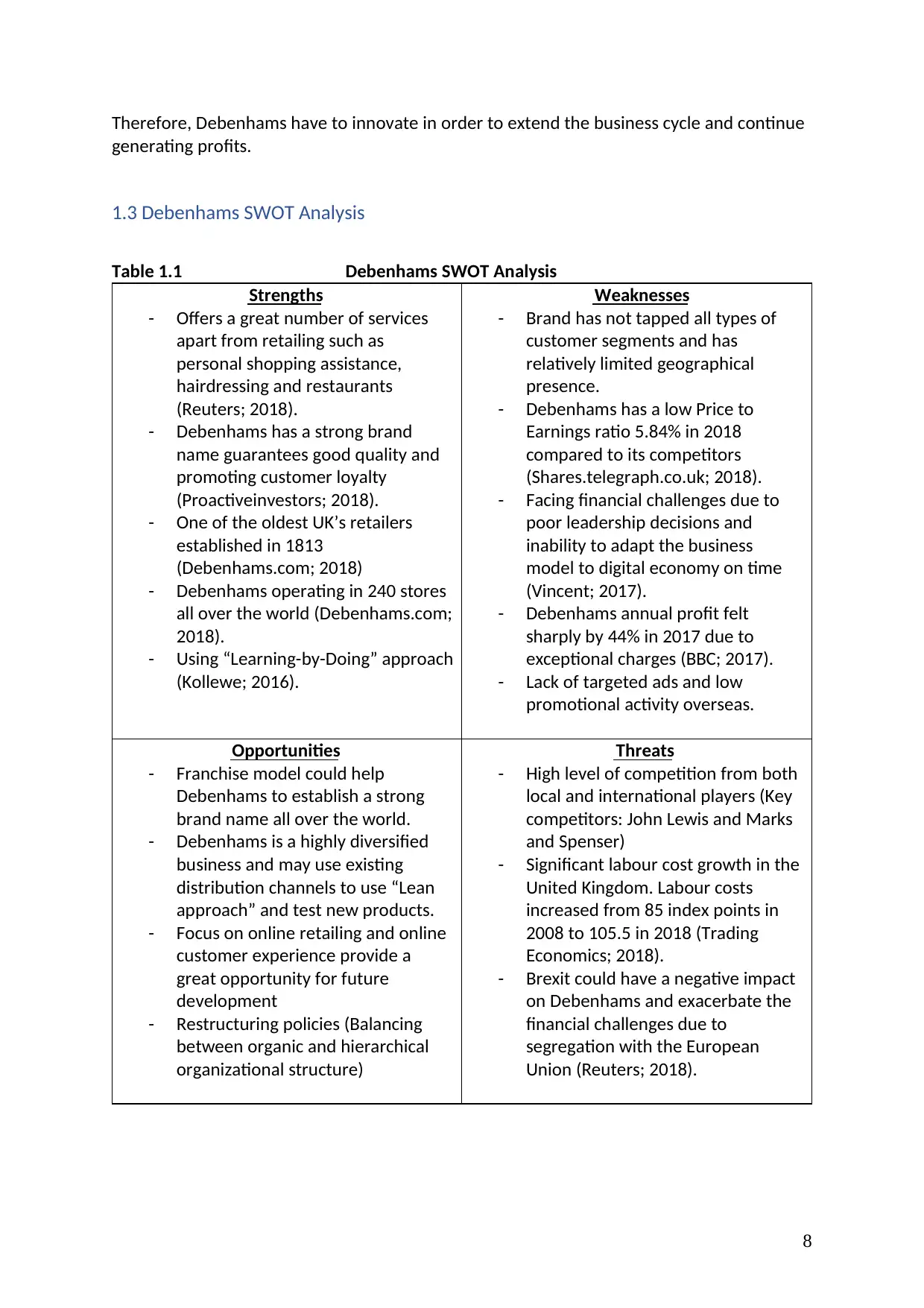
8
Therefore, Debenhams have to innovate in order to extend the business cycle and continue
generating profits.
1.3 Debenhams SWOT Analysis
Table 1.1 Debenhams SWOT Analysis
Strengths
- Offers a great number of services
apart from retailing such as
personal shopping assistance,
hairdressing and restaurants
(Reuters; 2018).
- Debenhams has a strong brand
name guarantees good quality and
promoting customer loyalty
(Proactiveinvestors; 2018).
- One of the oldest UK’s retailers
established in 1813
(Debenhams.com; 2018)
- Debenhams operating in 240 stores
all over the world (Debenhams.com;
2018).
- Using “Learning-by-Doing” approach
(Kollewe; 2016).
Weaknesses
- Brand has not tapped all types of
customer segments and has
relatively limited geographical
presence.
- Debenhams has a low Price to
Earnings ratio 5.84% in 2018
compared to its competitors
(Shares.telegraph.co.uk; 2018).
- Facing financial challenges due to
poor leadership decisions and
inability to adapt the business
model to digital economy on time
(Vincent; 2017).
- Debenhams annual profit felt
sharply by 44% in 2017 due to
exceptional charges (BBC; 2017).
- Lack of targeted ads and low
promotional activity overseas.
Opportunities
- Franchise model could help
Debenhams to establish a strong
brand name all over the world.
- Debenhams is a highly diversified
business and may use existing
distribution channels to use “Lean
approach” and test new products.
- Focus on online retailing and online
customer experience provide a
great opportunity for future
development
- Restructuring policies (Balancing
between organic and hierarchical
organizational structure)
Threats
- High level of competition from both
local and international players (Key
competitors: John Lewis and Marks
and Spenser)
- Significant labour cost growth in the
United Kingdom. Labour costs
increased from 85 index points in
2008 to 105.5 in 2018 (Trading
Economics; 2018).
- Brexit could have a negative impact
on Debenhams and exacerbate the
financial challenges due to
segregation with the European
Union (Reuters; 2018).
Therefore, Debenhams have to innovate in order to extend the business cycle and continue
generating profits.
1.3 Debenhams SWOT Analysis
Table 1.1 Debenhams SWOT Analysis
Strengths
- Offers a great number of services
apart from retailing such as
personal shopping assistance,
hairdressing and restaurants
(Reuters; 2018).
- Debenhams has a strong brand
name guarantees good quality and
promoting customer loyalty
(Proactiveinvestors; 2018).
- One of the oldest UK’s retailers
established in 1813
(Debenhams.com; 2018)
- Debenhams operating in 240 stores
all over the world (Debenhams.com;
2018).
- Using “Learning-by-Doing” approach
(Kollewe; 2016).
Weaknesses
- Brand has not tapped all types of
customer segments and has
relatively limited geographical
presence.
- Debenhams has a low Price to
Earnings ratio 5.84% in 2018
compared to its competitors
(Shares.telegraph.co.uk; 2018).
- Facing financial challenges due to
poor leadership decisions and
inability to adapt the business
model to digital economy on time
(Vincent; 2017).
- Debenhams annual profit felt
sharply by 44% in 2017 due to
exceptional charges (BBC; 2017).
- Lack of targeted ads and low
promotional activity overseas.
Opportunities
- Franchise model could help
Debenhams to establish a strong
brand name all over the world.
- Debenhams is a highly diversified
business and may use existing
distribution channels to use “Lean
approach” and test new products.
- Focus on online retailing and online
customer experience provide a
great opportunity for future
development
- Restructuring policies (Balancing
between organic and hierarchical
organizational structure)
Threats
- High level of competition from both
local and international players (Key
competitors: John Lewis and Marks
and Spenser)
- Significant labour cost growth in the
United Kingdom. Labour costs
increased from 85 index points in
2008 to 105.5 in 2018 (Trading
Economics; 2018).
- Brexit could have a negative impact
on Debenhams and exacerbate the
financial challenges due to
segregation with the European
Union (Reuters; 2018).
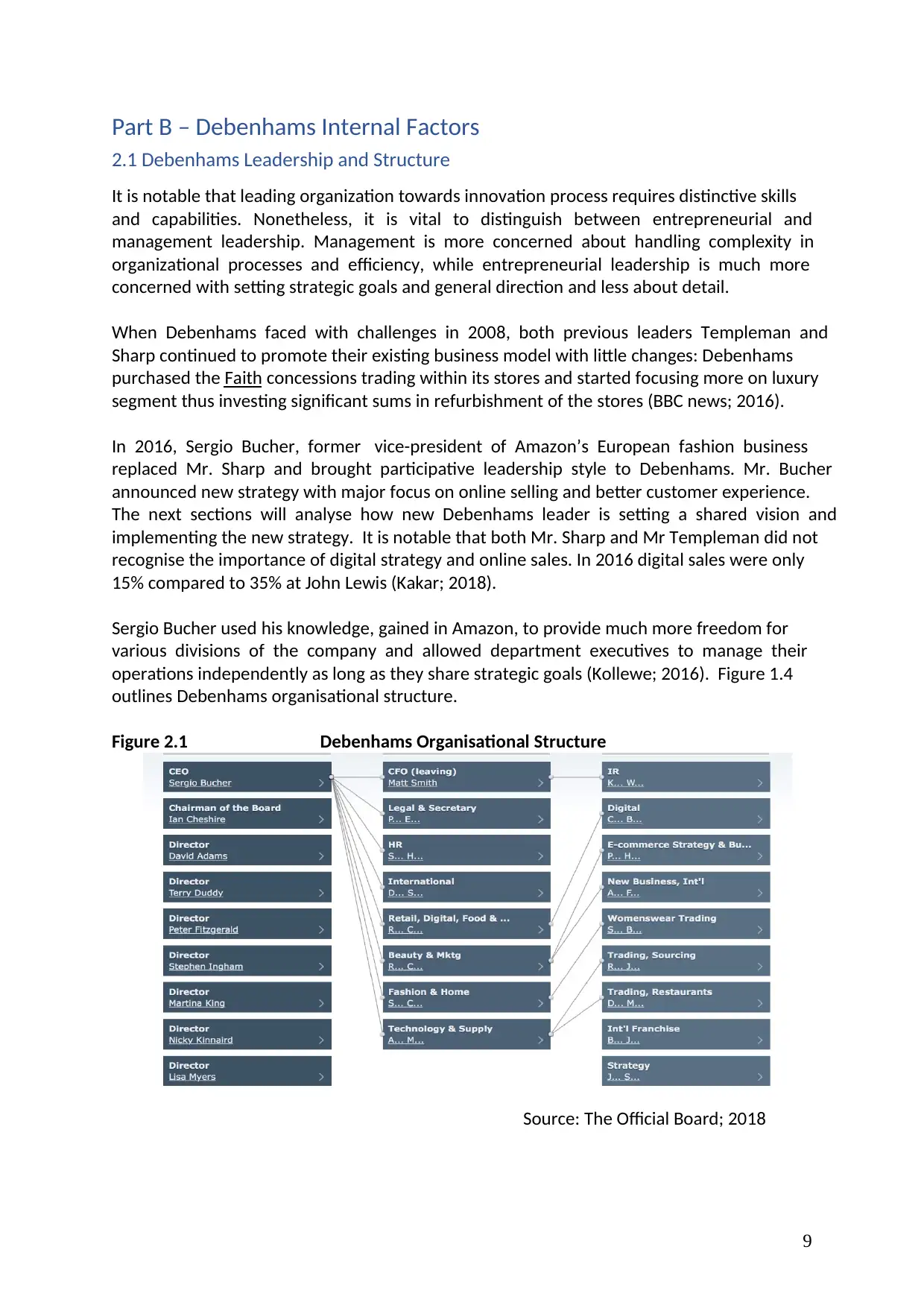
9
Part B – Debenhams Internal Factors
2.1 Debenhams Leadership and Structure
It is notable that leading organization towards innovation process requires distinctive skills
and capabilities. Nonetheless, it is vital to distinguish between entrepreneurial and
management leadership. Management is more concerned about handling complexity in
organizational processes and efficiency, while entrepreneurial leadership is much more
concerned with setting strategic goals and general direction and less about detail.
When Debenhams faced with challenges in 2008, both previous leaders Templeman and
Sharp continued to promote their existing business model with little changes: Debenhams
purchased the Faith concessions trading within its stores and started focusing more on luxury
segment thus investing significant sums in refurbishment of the stores (BBC news; 2016).
In 2016, Sergio Bucher, former vice-president of Amazon’s European fashion business
replaced Mr. Sharp and brought participative leadership style to Debenhams. Mr. Bucher
announced new strategy with major focus on online selling and better customer experience.
The next sections will analyse how new Debenhams leader is setting a shared vision and
implementing the new strategy. It is notable that both Mr. Sharp and Mr Templeman did not
recognise the importance of digital strategy and online sales. In 2016 digital sales were only
15% compared to 35% at John Lewis (Kakar; 2018).
Sergio Bucher used his knowledge, gained in Amazon, to provide much more freedom for
various divisions of the company and allowed department executives to manage their
operations independently as long as they share strategic goals (Kollewe; 2016). Figure 1.4
outlines Debenhams organisational structure.
Figure 2.1 Debenhams Organisational Structure
Source: The Official Board; 2018
Part B – Debenhams Internal Factors
2.1 Debenhams Leadership and Structure
It is notable that leading organization towards innovation process requires distinctive skills
and capabilities. Nonetheless, it is vital to distinguish between entrepreneurial and
management leadership. Management is more concerned about handling complexity in
organizational processes and efficiency, while entrepreneurial leadership is much more
concerned with setting strategic goals and general direction and less about detail.
When Debenhams faced with challenges in 2008, both previous leaders Templeman and
Sharp continued to promote their existing business model with little changes: Debenhams
purchased the Faith concessions trading within its stores and started focusing more on luxury
segment thus investing significant sums in refurbishment of the stores (BBC news; 2016).
In 2016, Sergio Bucher, former vice-president of Amazon’s European fashion business
replaced Mr. Sharp and brought participative leadership style to Debenhams. Mr. Bucher
announced new strategy with major focus on online selling and better customer experience.
The next sections will analyse how new Debenhams leader is setting a shared vision and
implementing the new strategy. It is notable that both Mr. Sharp and Mr Templeman did not
recognise the importance of digital strategy and online sales. In 2016 digital sales were only
15% compared to 35% at John Lewis (Kakar; 2018).
Sergio Bucher used his knowledge, gained in Amazon, to provide much more freedom for
various divisions of the company and allowed department executives to manage their
operations independently as long as they share strategic goals (Kollewe; 2016). Figure 1.4
outlines Debenhams organisational structure.
Figure 2.1 Debenhams Organisational Structure
Source: The Official Board; 2018
⊘ This is a preview!⊘
Do you want full access?
Subscribe today to unlock all pages.

Trusted by 1+ million students worldwide
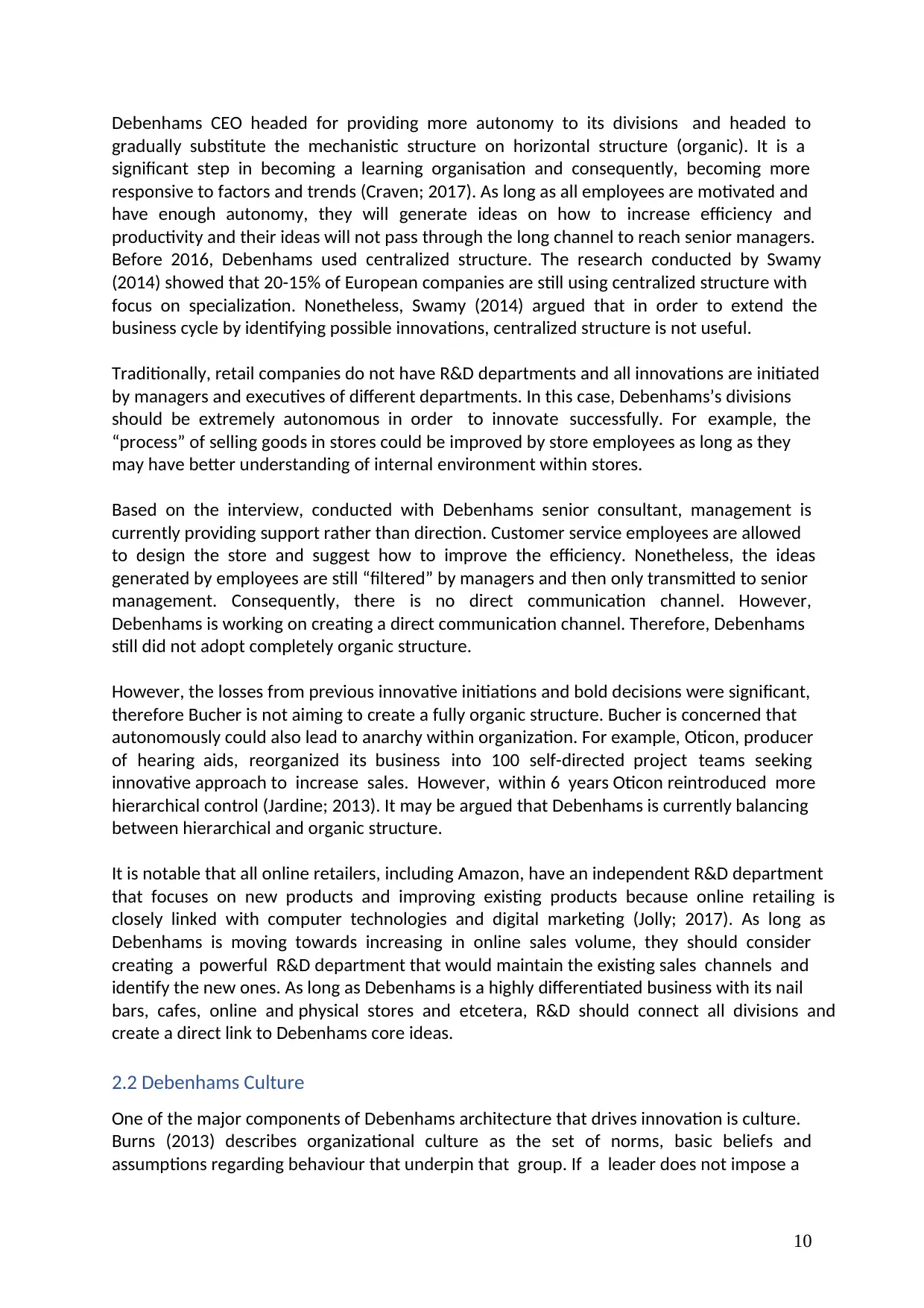
10
Debenhams CEO headed for providing more autonomy to its divisions and headed to
gradually substitute the mechanistic structure on horizontal structure (organic). It is a
significant step in becoming a learning organisation and consequently, becoming more
responsive to factors and trends (Craven; 2017). As long as all employees are motivated and
have enough autonomy, they will generate ideas on how to increase efficiency and
productivity and their ideas will not pass through the long channel to reach senior managers.
Before 2016, Debenhams used centralized structure. The research conducted by Swamy
(2014) showed that 20-15% of European companies are still using centralized structure with
focus on specialization. Nonetheless, Swamy (2014) argued that in order to extend the
business cycle by identifying possible innovations, centralized structure is not useful.
Traditionally, retail companies do not have R&D departments and all innovations are initiated
by managers and executives of different departments. In this case, Debenhams’s divisions
should be extremely autonomous in order to innovate successfully. For example, the
“process” of selling goods in stores could be improved by store employees as long as they
may have better understanding of internal environment within stores.
Based on the interview, conducted with Debenhams senior consultant, management is
currently providing support rather than direction. Customer service employees are allowed
to design the store and suggest how to improve the efficiency. Nonetheless, the ideas
generated by employees are still “filtered” by managers and then only transmitted to senior
management. Consequently, there is no direct communication channel. However,
Debenhams is working on creating a direct communication channel. Therefore, Debenhams
still did not adopt completely organic structure.
However, the losses from previous innovative initiations and bold decisions were significant,
therefore Bucher is not aiming to create a fully organic structure. Bucher is concerned that
autonomously could also lead to anarchy within organization. For example, Oticon, producer
of hearing aids, reorganized its business into 100 self-directed project teams seeking
innovative approach to increase sales. However, within 6 years Oticon reintroduced more
hierarchical control (Jardine; 2013). It may be argued that Debenhams is currently balancing
between hierarchical and organic structure.
It is notable that all online retailers, including Amazon, have an independent R&D department
that focuses on new products and improving existing products because online retailing is
closely linked with computer technologies and digital marketing (Jolly; 2017). As long as
Debenhams is moving towards increasing in online sales volume, they should consider
creating a powerful R&D department that would maintain the existing sales channels and
identify the new ones. As long as Debenhams is a highly differentiated business with its nail
bars, cafes, online and physical stores and etcetera, R&D should connect all divisions and
create a direct link to Debenhams core ideas.
2.2 Debenhams Culture
One of the major components of Debenhams architecture that drives innovation is culture.
Burns (2013) describes organizational culture as the set of norms, basic beliefs and
assumptions regarding behaviour that underpin that group. If a leader does not impose a
Debenhams CEO headed for providing more autonomy to its divisions and headed to
gradually substitute the mechanistic structure on horizontal structure (organic). It is a
significant step in becoming a learning organisation and consequently, becoming more
responsive to factors and trends (Craven; 2017). As long as all employees are motivated and
have enough autonomy, they will generate ideas on how to increase efficiency and
productivity and their ideas will not pass through the long channel to reach senior managers.
Before 2016, Debenhams used centralized structure. The research conducted by Swamy
(2014) showed that 20-15% of European companies are still using centralized structure with
focus on specialization. Nonetheless, Swamy (2014) argued that in order to extend the
business cycle by identifying possible innovations, centralized structure is not useful.
Traditionally, retail companies do not have R&D departments and all innovations are initiated
by managers and executives of different departments. In this case, Debenhams’s divisions
should be extremely autonomous in order to innovate successfully. For example, the
“process” of selling goods in stores could be improved by store employees as long as they
may have better understanding of internal environment within stores.
Based on the interview, conducted with Debenhams senior consultant, management is
currently providing support rather than direction. Customer service employees are allowed
to design the store and suggest how to improve the efficiency. Nonetheless, the ideas
generated by employees are still “filtered” by managers and then only transmitted to senior
management. Consequently, there is no direct communication channel. However,
Debenhams is working on creating a direct communication channel. Therefore, Debenhams
still did not adopt completely organic structure.
However, the losses from previous innovative initiations and bold decisions were significant,
therefore Bucher is not aiming to create a fully organic structure. Bucher is concerned that
autonomously could also lead to anarchy within organization. For example, Oticon, producer
of hearing aids, reorganized its business into 100 self-directed project teams seeking
innovative approach to increase sales. However, within 6 years Oticon reintroduced more
hierarchical control (Jardine; 2013). It may be argued that Debenhams is currently balancing
between hierarchical and organic structure.
It is notable that all online retailers, including Amazon, have an independent R&D department
that focuses on new products and improving existing products because online retailing is
closely linked with computer technologies and digital marketing (Jolly; 2017). As long as
Debenhams is moving towards increasing in online sales volume, they should consider
creating a powerful R&D department that would maintain the existing sales channels and
identify the new ones. As long as Debenhams is a highly differentiated business with its nail
bars, cafes, online and physical stores and etcetera, R&D should connect all divisions and
create a direct link to Debenhams core ideas.
2.2 Debenhams Culture
One of the major components of Debenhams architecture that drives innovation is culture.
Burns (2013) describes organizational culture as the set of norms, basic beliefs and
assumptions regarding behaviour that underpin that group. If a leader does not impose a
Paraphrase This Document
Need a fresh take? Get an instant paraphrase of this document with our AI Paraphraser
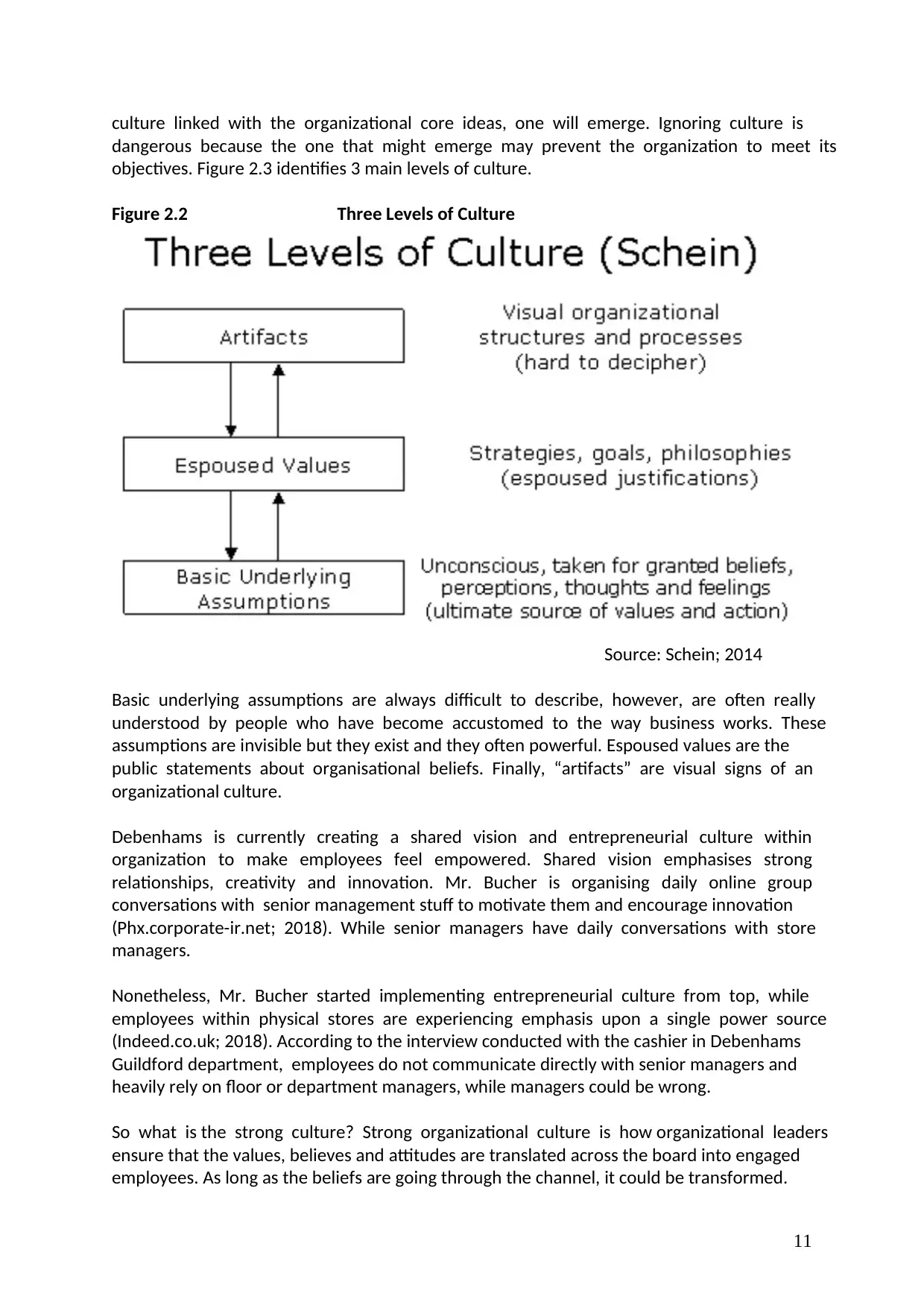
11
culture linked with the organizational core ideas, one will emerge. Ignoring culture is
dangerous because the one that might emerge may prevent the organization to meet its
objectives. Figure 2.3 identifies 3 main levels of culture.
Figure 2.2 Three Levels of Culture
Source: Schein; 2014
Basic underlying assumptions are always difficult to describe, however, are often really
understood by people who have become accustomed to the way business works. These
assumptions are invisible but they exist and they often powerful. Espoused values are the
public statements about organisational beliefs. Finally, “artifacts” are visual signs of an
organizational culture.
Debenhams is currently creating a shared vision and entrepreneurial culture within
organization to make employees feel empowered. Shared vision emphasises strong
relationships, creativity and innovation. Mr. Bucher is organising daily online group
conversations with senior management stuff to motivate them and encourage innovation
(Phx.corporate-ir.net; 2018). While senior managers have daily conversations with store
managers.
Nonetheless, Mr. Bucher started implementing entrepreneurial culture from top, while
employees within physical stores are experiencing emphasis upon a single power source
(Indeed.co.uk; 2018). According to the interview conducted with the cashier in Debenhams
Guildford department, employees do not communicate directly with senior managers and
heavily rely on floor or department managers, while managers could be wrong.
So what is the strong culture? Strong organizational culture is how organizational leaders
ensure that the values, believes and attitudes are translated across the board into engaged
employees. As long as the beliefs are going through the channel, it could be transformed.
culture linked with the organizational core ideas, one will emerge. Ignoring culture is
dangerous because the one that might emerge may prevent the organization to meet its
objectives. Figure 2.3 identifies 3 main levels of culture.
Figure 2.2 Three Levels of Culture
Source: Schein; 2014
Basic underlying assumptions are always difficult to describe, however, are often really
understood by people who have become accustomed to the way business works. These
assumptions are invisible but they exist and they often powerful. Espoused values are the
public statements about organisational beliefs. Finally, “artifacts” are visual signs of an
organizational culture.
Debenhams is currently creating a shared vision and entrepreneurial culture within
organization to make employees feel empowered. Shared vision emphasises strong
relationships, creativity and innovation. Mr. Bucher is organising daily online group
conversations with senior management stuff to motivate them and encourage innovation
(Phx.corporate-ir.net; 2018). While senior managers have daily conversations with store
managers.
Nonetheless, Mr. Bucher started implementing entrepreneurial culture from top, while
employees within physical stores are experiencing emphasis upon a single power source
(Indeed.co.uk; 2018). According to the interview conducted with the cashier in Debenhams
Guildford department, employees do not communicate directly with senior managers and
heavily rely on floor or department managers, while managers could be wrong.
So what is the strong culture? Strong organizational culture is how organizational leaders
ensure that the values, believes and attitudes are translated across the board into engaged
employees. As long as the beliefs are going through the channel, it could be transformed.
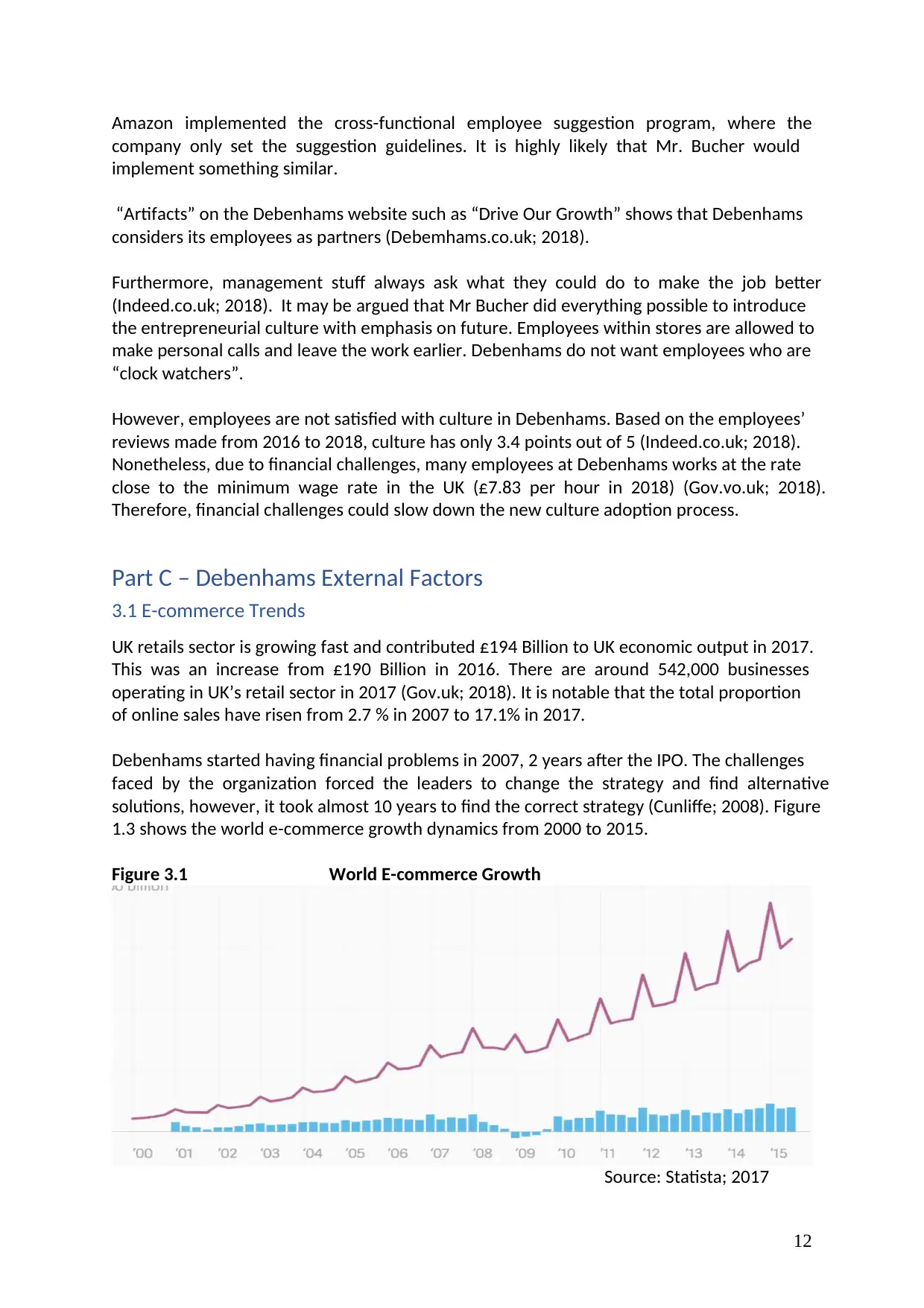
12
Amazon implemented the cross-functional employee suggestion program, where the
company only set the suggestion guidelines. It is highly likely that Mr. Bucher would
implement something similar.
“Artifacts” on the Debenhams website such as “Drive Our Growth” shows that Debenhams
considers its employees as partners (Debemhams.co.uk; 2018).
Furthermore, management stuff always ask what they could do to make the job better
(Indeed.co.uk; 2018). It may be argued that Mr Bucher did everything possible to introduce
the entrepreneurial culture with emphasis on future. Employees within stores are allowed to
make personal calls and leave the work earlier. Debenhams do not want employees who are
“clock watchers”.
However, employees are not satisfied with culture in Debenhams. Based on the employees’
reviews made from 2016 to 2018, culture has only 3.4 points out of 5 (Indeed.co.uk; 2018).
Nonetheless, due to financial challenges, many employees at Debenhams works at the rate
close to the minimum wage rate in the UK (£7.83 per hour in 2018) (Gov.vo.uk; 2018).
Therefore, financial challenges could slow down the new culture adoption process.
Part C – Debenhams External Factors
3.1 E-commerce Trends
UK retails sector is growing fast and contributed £194 Billion to UK economic output in 2017.
This was an increase from £190 Billion in 2016. There are around 542,000 businesses
operating in UK’s retail sector in 2017 (Gov.uk; 2018). It is notable that the total proportion
of online sales have risen from 2.7 % in 2007 to 17.1% in 2017.
Debenhams started having financial problems in 2007, 2 years after the IPO. The challenges
faced by the organization forced the leaders to change the strategy and find alternative
solutions, however, it took almost 10 years to find the correct strategy (Cunliffe; 2008). Figure
1.3 shows the world e-commerce growth dynamics from 2000 to 2015.
Figure 3.1 World E-commerce Growth
Source: Statista; 2017
Amazon implemented the cross-functional employee suggestion program, where the
company only set the suggestion guidelines. It is highly likely that Mr. Bucher would
implement something similar.
“Artifacts” on the Debenhams website such as “Drive Our Growth” shows that Debenhams
considers its employees as partners (Debemhams.co.uk; 2018).
Furthermore, management stuff always ask what they could do to make the job better
(Indeed.co.uk; 2018). It may be argued that Mr Bucher did everything possible to introduce
the entrepreneurial culture with emphasis on future. Employees within stores are allowed to
make personal calls and leave the work earlier. Debenhams do not want employees who are
“clock watchers”.
However, employees are not satisfied with culture in Debenhams. Based on the employees’
reviews made from 2016 to 2018, culture has only 3.4 points out of 5 (Indeed.co.uk; 2018).
Nonetheless, due to financial challenges, many employees at Debenhams works at the rate
close to the minimum wage rate in the UK (£7.83 per hour in 2018) (Gov.vo.uk; 2018).
Therefore, financial challenges could slow down the new culture adoption process.
Part C – Debenhams External Factors
3.1 E-commerce Trends
UK retails sector is growing fast and contributed £194 Billion to UK economic output in 2017.
This was an increase from £190 Billion in 2016. There are around 542,000 businesses
operating in UK’s retail sector in 2017 (Gov.uk; 2018). It is notable that the total proportion
of online sales have risen from 2.7 % in 2007 to 17.1% in 2017.
Debenhams started having financial problems in 2007, 2 years after the IPO. The challenges
faced by the organization forced the leaders to change the strategy and find alternative
solutions, however, it took almost 10 years to find the correct strategy (Cunliffe; 2008). Figure
1.3 shows the world e-commerce growth dynamics from 2000 to 2015.
Figure 3.1 World E-commerce Growth
Source: Statista; 2017
⊘ This is a preview!⊘
Do you want full access?
Subscribe today to unlock all pages.

Trusted by 1+ million students worldwide
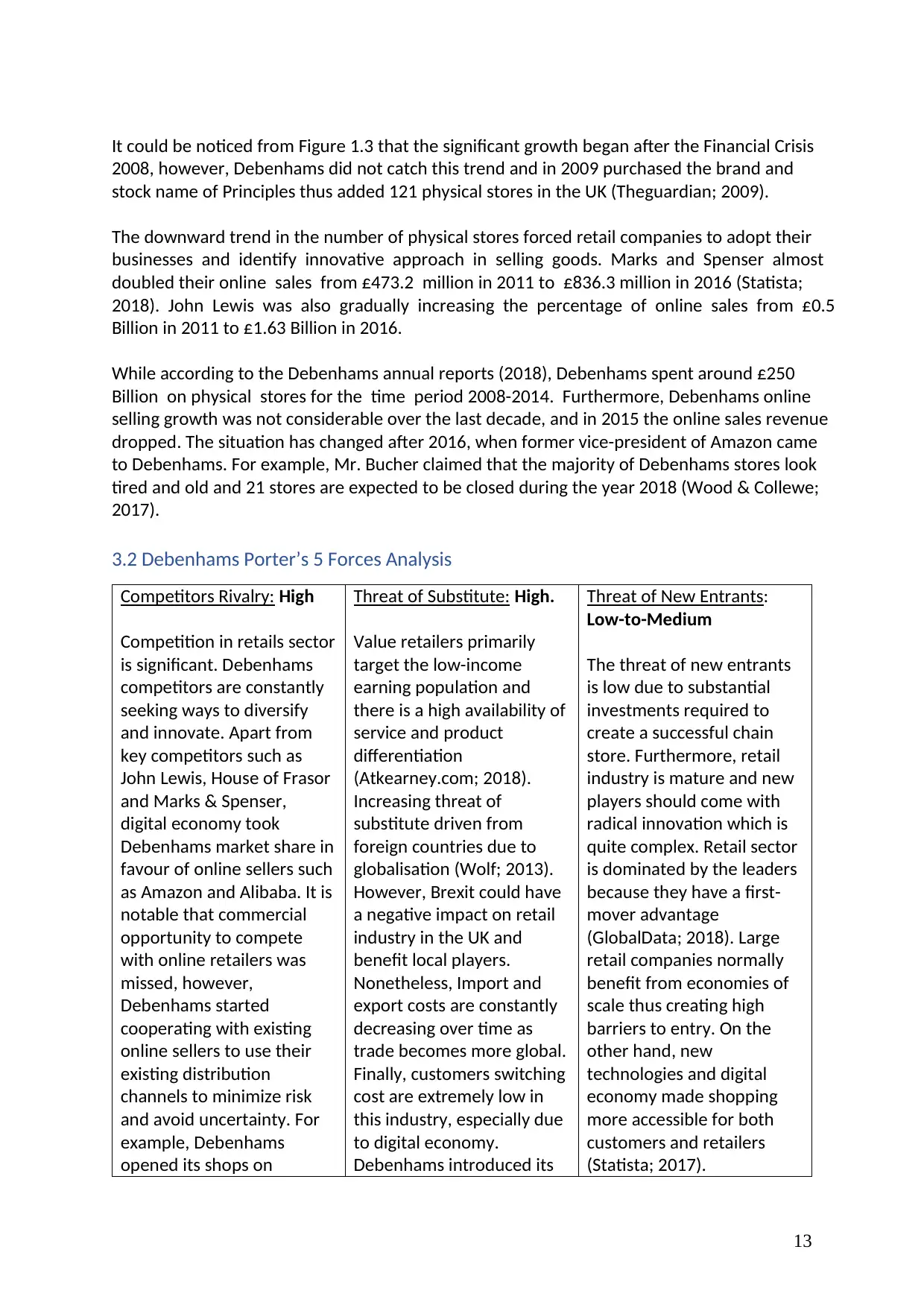
13
It could be noticed from Figure 1.3 that the significant growth began after the Financial Crisis
2008, however, Debenhams did not catch this trend and in 2009 purchased the brand and
stock name of Principles thus added 121 physical stores in the UK (Theguardian; 2009).
The downward trend in the number of physical stores forced retail companies to adopt their
businesses and identify innovative approach in selling goods. Marks and Spenser almost
doubled their online sales from £473.2 million in 2011 to £836.3 million in 2016 (Statista;
2018). John Lewis was also gradually increasing the percentage of online sales from £0.5
Billion in 2011 to £1.63 Billion in 2016.
While according to the Debenhams annual reports (2018), Debenhams spent around £250
Billion on physical stores for the time period 2008-2014. Furthermore, Debenhams online
selling growth was not considerable over the last decade, and in 2015 the online sales revenue
dropped. The situation has changed after 2016, when former vice-president of Amazon came
to Debenhams. For example, Mr. Bucher claimed that the majority of Debenhams stores look
tired and old and 21 stores are expected to be closed during the year 2018 (Wood & Collewe;
2017).
3.2 Debenhams Porter’s 5 Forces Analysis
Competitors Rivalry: High
Competition in retails sector
is significant. Debenhams
competitors are constantly
seeking ways to diversify
and innovate. Apart from
key competitors such as
John Lewis, House of Frasor
and Marks & Spenser,
digital economy took
Debenhams market share in
favour of online sellers such
as Amazon and Alibaba. It is
notable that commercial
opportunity to compete
with online retailers was
missed, however,
Debenhams started
cooperating with existing
online sellers to use their
existing distribution
channels to minimize risk
and avoid uncertainty. For
example, Debenhams
opened its shops on
Threat of Substitute: High.
Value retailers primarily
target the low-income
earning population and
there is a high availability of
service and product
differentiation
(Atkearney.com; 2018).
Increasing threat of
substitute driven from
foreign countries due to
globalisation (Wolf; 2013).
However, Brexit could have
a negative impact on retail
industry in the UK and
benefit local players.
Nonetheless, Import and
export costs are constantly
decreasing over time as
trade becomes more global.
Finally, customers switching
cost are extremely low in
this industry, especially due
to digital economy.
Debenhams introduced its
Threat of New Entrants:
Low-to-Medium
The threat of new entrants
is low due to substantial
investments required to
create a successful chain
store. Furthermore, retail
industry is mature and new
players should come with
radical innovation which is
quite complex. Retail sector
is dominated by the leaders
because they have a first-
mover advantage
(GlobalData; 2018). Large
retail companies normally
benefit from economies of
scale thus creating high
barriers to entry. On the
other hand, new
technologies and digital
economy made shopping
more accessible for both
customers and retailers
(Statista; 2017).
It could be noticed from Figure 1.3 that the significant growth began after the Financial Crisis
2008, however, Debenhams did not catch this trend and in 2009 purchased the brand and
stock name of Principles thus added 121 physical stores in the UK (Theguardian; 2009).
The downward trend in the number of physical stores forced retail companies to adopt their
businesses and identify innovative approach in selling goods. Marks and Spenser almost
doubled their online sales from £473.2 million in 2011 to £836.3 million in 2016 (Statista;
2018). John Lewis was also gradually increasing the percentage of online sales from £0.5
Billion in 2011 to £1.63 Billion in 2016.
While according to the Debenhams annual reports (2018), Debenhams spent around £250
Billion on physical stores for the time period 2008-2014. Furthermore, Debenhams online
selling growth was not considerable over the last decade, and in 2015 the online sales revenue
dropped. The situation has changed after 2016, when former vice-president of Amazon came
to Debenhams. For example, Mr. Bucher claimed that the majority of Debenhams stores look
tired and old and 21 stores are expected to be closed during the year 2018 (Wood & Collewe;
2017).
3.2 Debenhams Porter’s 5 Forces Analysis
Competitors Rivalry: High
Competition in retails sector
is significant. Debenhams
competitors are constantly
seeking ways to diversify
and innovate. Apart from
key competitors such as
John Lewis, House of Frasor
and Marks & Spenser,
digital economy took
Debenhams market share in
favour of online sellers such
as Amazon and Alibaba. It is
notable that commercial
opportunity to compete
with online retailers was
missed, however,
Debenhams started
cooperating with existing
online sellers to use their
existing distribution
channels to minimize risk
and avoid uncertainty. For
example, Debenhams
opened its shops on
Threat of Substitute: High.
Value retailers primarily
target the low-income
earning population and
there is a high availability of
service and product
differentiation
(Atkearney.com; 2018).
Increasing threat of
substitute driven from
foreign countries due to
globalisation (Wolf; 2013).
However, Brexit could have
a negative impact on retail
industry in the UK and
benefit local players.
Nonetheless, Import and
export costs are constantly
decreasing over time as
trade becomes more global.
Finally, customers switching
cost are extremely low in
this industry, especially due
to digital economy.
Debenhams introduced its
Threat of New Entrants:
Low-to-Medium
The threat of new entrants
is low due to substantial
investments required to
create a successful chain
store. Furthermore, retail
industry is mature and new
players should come with
radical innovation which is
quite complex. Retail sector
is dominated by the leaders
because they have a first-
mover advantage
(GlobalData; 2018). Large
retail companies normally
benefit from economies of
scale thus creating high
barriers to entry. On the
other hand, new
technologies and digital
economy made shopping
more accessible for both
customers and retailers
(Statista; 2017).
Paraphrase This Document
Need a fresh take? Get an instant paraphrase of this document with our AI Paraphraser
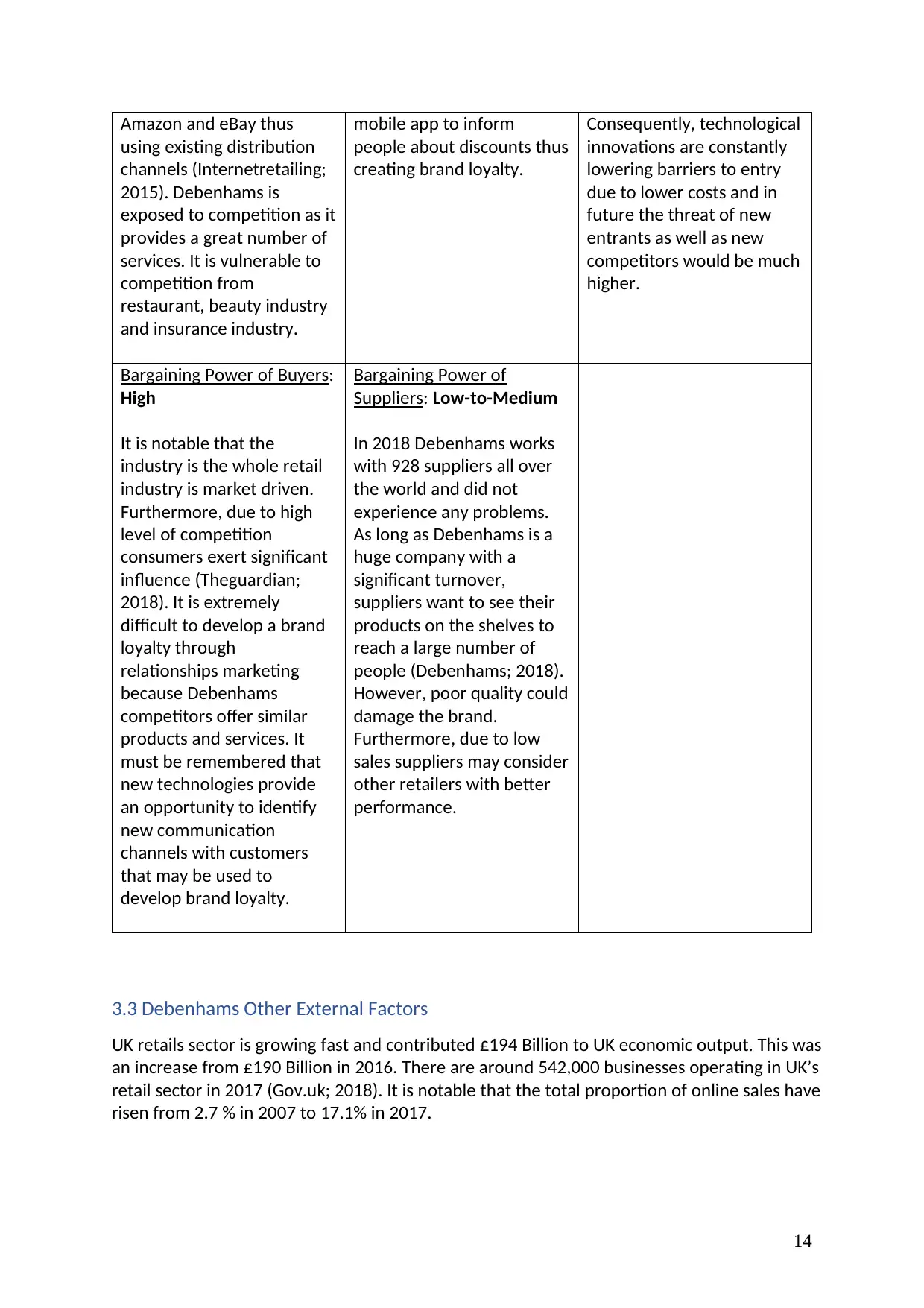
14
Amazon and eBay thus
using existing distribution
channels (Internetretailing;
2015). Debenhams is
exposed to competition as it
provides a great number of
services. It is vulnerable to
competition from
restaurant, beauty industry
and insurance industry.
mobile app to inform
people about discounts thus
creating brand loyalty.
Consequently, technological
innovations are constantly
lowering barriers to entry
due to lower costs and in
future the threat of new
entrants as well as new
competitors would be much
higher.
Bargaining Power of Buyers:
High
It is notable that the
industry is the whole retail
industry is market driven.
Furthermore, due to high
level of competition
consumers exert significant
influence (Theguardian;
2018). It is extremely
difficult to develop a brand
loyalty through
relationships marketing
because Debenhams
competitors offer similar
products and services. It
must be remembered that
new technologies provide
an opportunity to identify
new communication
channels with customers
that may be used to
develop brand loyalty.
Bargaining Power of
Suppliers: Low-to-Medium
In 2018 Debenhams works
with 928 suppliers all over
the world and did not
experience any problems.
As long as Debenhams is a
huge company with a
significant turnover,
suppliers want to see their
products on the shelves to
reach a large number of
people (Debenhams; 2018).
However, poor quality could
damage the brand.
Furthermore, due to low
sales suppliers may consider
other retailers with better
performance.
3.3 Debenhams Other External Factors
UK retails sector is growing fast and contributed £194 Billion to UK economic output. This was
an increase from £190 Billion in 2016. There are around 542,000 businesses operating in UK’s
retail sector in 2017 (Gov.uk; 2018). It is notable that the total proportion of online sales have
risen from 2.7 % in 2007 to 17.1% in 2017.
Amazon and eBay thus
using existing distribution
channels (Internetretailing;
2015). Debenhams is
exposed to competition as it
provides a great number of
services. It is vulnerable to
competition from
restaurant, beauty industry
and insurance industry.
mobile app to inform
people about discounts thus
creating brand loyalty.
Consequently, technological
innovations are constantly
lowering barriers to entry
due to lower costs and in
future the threat of new
entrants as well as new
competitors would be much
higher.
Bargaining Power of Buyers:
High
It is notable that the
industry is the whole retail
industry is market driven.
Furthermore, due to high
level of competition
consumers exert significant
influence (Theguardian;
2018). It is extremely
difficult to develop a brand
loyalty through
relationships marketing
because Debenhams
competitors offer similar
products and services. It
must be remembered that
new technologies provide
an opportunity to identify
new communication
channels with customers
that may be used to
develop brand loyalty.
Bargaining Power of
Suppliers: Low-to-Medium
In 2018 Debenhams works
with 928 suppliers all over
the world and did not
experience any problems.
As long as Debenhams is a
huge company with a
significant turnover,
suppliers want to see their
products on the shelves to
reach a large number of
people (Debenhams; 2018).
However, poor quality could
damage the brand.
Furthermore, due to low
sales suppliers may consider
other retailers with better
performance.
3.3 Debenhams Other External Factors
UK retails sector is growing fast and contributed £194 Billion to UK economic output. This was
an increase from £190 Billion in 2016. There are around 542,000 businesses operating in UK’s
retail sector in 2017 (Gov.uk; 2018). It is notable that the total proportion of online sales have
risen from 2.7 % in 2007 to 17.1% in 2017.
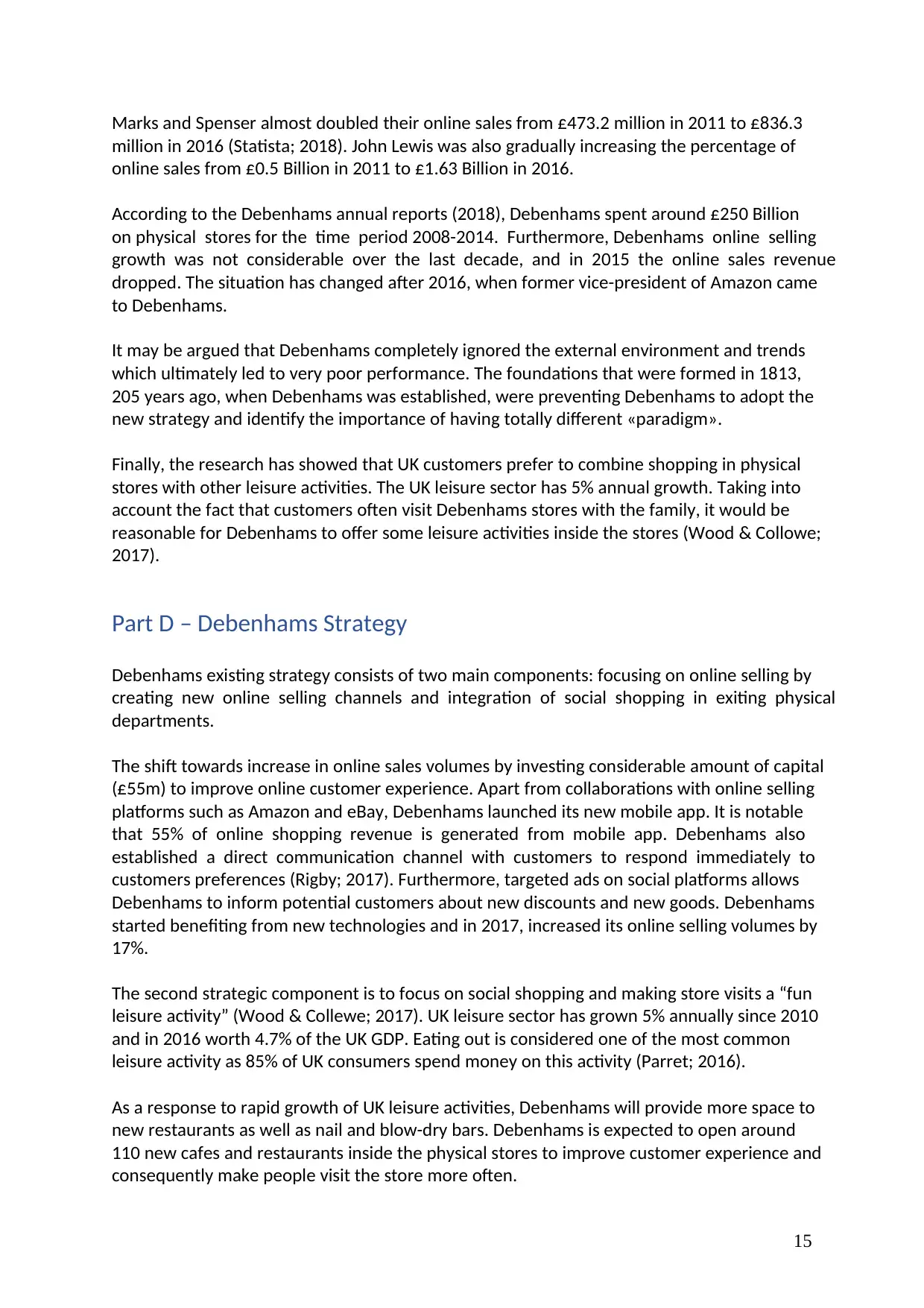
15
Marks and Spenser almost doubled their online sales from £473.2 million in 2011 to £836.3
million in 2016 (Statista; 2018). John Lewis was also gradually increasing the percentage of
online sales from £0.5 Billion in 2011 to £1.63 Billion in 2016.
According to the Debenhams annual reports (2018), Debenhams spent around £250 Billion
on physical stores for the time period 2008-2014. Furthermore, Debenhams online selling
growth was not considerable over the last decade, and in 2015 the online sales revenue
dropped. The situation has changed after 2016, when former vice-president of Amazon came
to Debenhams.
It may be argued that Debenhams completely ignored the external environment and trends
which ultimately led to very poor performance. The foundations that were formed in 1813,
205 years ago, when Debenhams was established, were preventing Debenhams to adopt the
new strategy and identify the importance of having totally different «paradigm».
Finally, the research has showed that UK customers prefer to combine shopping in physical
stores with other leisure activities. The UK leisure sector has 5% annual growth. Taking into
account the fact that customers often visit Debenhams stores with the family, it would be
reasonable for Debenhams to offer some leisure activities inside the stores (Wood & Collowe;
2017).
Part D – Debenhams Strategy
Debenhams existing strategy consists of two main components: focusing on online selling by
creating new online selling channels and integration of social shopping in exiting physical
departments.
The shift towards increase in online sales volumes by investing considerable amount of capital
(£55m) to improve online customer experience. Apart from collaborations with online selling
platforms such as Amazon and eBay, Debenhams launched its new mobile app. It is notable
that 55% of online shopping revenue is generated from mobile app. Debenhams also
established a direct communication channel with customers to respond immediately to
customers preferences (Rigby; 2017). Furthermore, targeted ads on social platforms allows
Debenhams to inform potential customers about new discounts and new goods. Debenhams
started benefiting from new technologies and in 2017, increased its online selling volumes by
17%.
The second strategic component is to focus on social shopping and making store visits a “fun
leisure activity” (Wood & Collewe; 2017). UK leisure sector has grown 5% annually since 2010
and in 2016 worth 4.7% of the UK GDP. Eating out is considered one of the most common
leisure activity as 85% of UK consumers spend money on this activity (Parret; 2016).
As a response to rapid growth of UK leisure activities, Debenhams will provide more space to
new restaurants as well as nail and blow-dry bars. Debenhams is expected to open around
110 new cafes and restaurants inside the physical stores to improve customer experience and
consequently make people visit the store more often.
Marks and Spenser almost doubled their online sales from £473.2 million in 2011 to £836.3
million in 2016 (Statista; 2018). John Lewis was also gradually increasing the percentage of
online sales from £0.5 Billion in 2011 to £1.63 Billion in 2016.
According to the Debenhams annual reports (2018), Debenhams spent around £250 Billion
on physical stores for the time period 2008-2014. Furthermore, Debenhams online selling
growth was not considerable over the last decade, and in 2015 the online sales revenue
dropped. The situation has changed after 2016, when former vice-president of Amazon came
to Debenhams.
It may be argued that Debenhams completely ignored the external environment and trends
which ultimately led to very poor performance. The foundations that were formed in 1813,
205 years ago, when Debenhams was established, were preventing Debenhams to adopt the
new strategy and identify the importance of having totally different «paradigm».
Finally, the research has showed that UK customers prefer to combine shopping in physical
stores with other leisure activities. The UK leisure sector has 5% annual growth. Taking into
account the fact that customers often visit Debenhams stores with the family, it would be
reasonable for Debenhams to offer some leisure activities inside the stores (Wood & Collowe;
2017).
Part D – Debenhams Strategy
Debenhams existing strategy consists of two main components: focusing on online selling by
creating new online selling channels and integration of social shopping in exiting physical
departments.
The shift towards increase in online sales volumes by investing considerable amount of capital
(£55m) to improve online customer experience. Apart from collaborations with online selling
platforms such as Amazon and eBay, Debenhams launched its new mobile app. It is notable
that 55% of online shopping revenue is generated from mobile app. Debenhams also
established a direct communication channel with customers to respond immediately to
customers preferences (Rigby; 2017). Furthermore, targeted ads on social platforms allows
Debenhams to inform potential customers about new discounts and new goods. Debenhams
started benefiting from new technologies and in 2017, increased its online selling volumes by
17%.
The second strategic component is to focus on social shopping and making store visits a “fun
leisure activity” (Wood & Collewe; 2017). UK leisure sector has grown 5% annually since 2010
and in 2016 worth 4.7% of the UK GDP. Eating out is considered one of the most common
leisure activity as 85% of UK consumers spend money on this activity (Parret; 2016).
As a response to rapid growth of UK leisure activities, Debenhams will provide more space to
new restaurants as well as nail and blow-dry bars. Debenhams is expected to open around
110 new cafes and restaurants inside the physical stores to improve customer experience and
consequently make people visit the store more often.
⊘ This is a preview!⊘
Do you want full access?
Subscribe today to unlock all pages.

Trusted by 1+ million students worldwide
1 out of 18
Related Documents
Your All-in-One AI-Powered Toolkit for Academic Success.
+13062052269
info@desklib.com
Available 24*7 on WhatsApp / Email
![[object Object]](/_next/static/media/star-bottom.7253800d.svg)
Unlock your academic potential
Copyright © 2020–2025 A2Z Services. All Rights Reserved. Developed and managed by ZUCOL.





